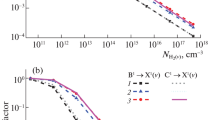Abstract
Working-level-population processes are analyzed on the basis of detailed investigations of the amplitude-time structure of the laser and spontaneous emission following a pulsed electric discharge in the mixtures He + R (R = Ar, Kr, Xe), Ar + Xe. Account is taken in the analysis of excitation by electrons (direct and stepwise) and of population as a result of relaxation processes (collisions of second kind with electrons; radiative cascades, recombination processes; collisions with the atoms of the working and buffer gases; excitation transfer from helium molecules). It is concluded that under optimum efficiency conditions inversion is produced in the lasers considered as a result of direct electron collision with the working atoms (Ar, Kr, Xe), which are in the ground state.
Similar content being viewed by others
Literature Cited
Tables of Physical Quantities [in Russian], Atomizdat, Moscow (1976).
A. A. Isaev and G. G. Petrash, “Investigation of pulsed atomic-transition gas lasers”, Tr. FIAN SSSR,81, 1–87 (1975).
G. J. Linford, “High-gain neutral laser lines in pulsed noble-gas discharges”, IEEE J. Quantum Electron.,QE-8, No. 6, 477–482 (1972).
J. W. McConkey and F. G. Donaldson, “Excitation of the resonance lines of Ar by electrons”, Can. J. Phys.,51, No. 9, 914–921 (1973).
I. P. Zapesochnyi and P. V. Fel'tsan, “Cross sections for excitation of argon, krypton, and xenon levels”, Opt. Spektrosk.,20, No. 3, 521–522 (1966).
W. Bennett and O. Heavens, Gas Lasers. Solid-State Lasers [Russian translation], Mir, Moscow (1964).
V. F. Moskalenko, E. P. Ostpachenko, and V. A. Chernikov, “Mechanism of pulsed lasing in an He−Xe mixture”, Opt. Spektrosk.,33, No. 2, 308–313 (1972).
P. L. Chapovsky, V. N. Lisitsyn, and A. R. Sorokin, “High-pressure gas lasers on ArI, XeI, and KrI transitions”, Opt. Commun.16, No. 1, 33–36 (1976).
A. R. Sorokin, “Energy characteristics of TEA ArI, KrI, and XeI lasers”, Zh. Tekh. Fiz.,49, No. 8, 1673–1677 (1979).
J. B. Shumaker and C. H. Popenoe, “Transition probabilities of ArI 4s-4p array”, J. Opt. Soc. Am.,57, No. 1, 8–10 (1967).
W. L. Faust and R. A. McFarlane, “Line strengths for noble-gas laser transitions; calculations of gain/inversion at various wavelengths”, J. Appl. Phys.,35, No. 7, 2010–2015 (1964).
R. A. Ohlson, D. Grosjean, W. Sarka, Jr., and A. Garscadden, “Closed-cycle electric-discharge inert-gas laser for scientific research”, Rev. Sci. Instrum.,44, No. 6, 677–683 (1976).
R. Shuker, A. Szoke, E. Zamir, and Y. Bimor, “Energy transfer in noble-gas mixtures: Penning ionization in He/Xe”, Phys. Rev.,A11, No. 4, 1187–1192 (1975).
R. Targ and M. W. Sasnett, “Xenon-helium laser at high pressure and high repetition rate”, Appl. Phys. Lett.,19, No. 12, 537–539 (1971).
T. S. Falen and R. Targ, “High-average-power xenon laser”, IEEE J. Quantum Electron.,QE-9, No. 6, 609 (1973).
S. A. Lawton, J. B. Richards, L. A. Newman, and T. A. De Temple, “The high-pressure neutral infrared xenon laser”, J. Appl. Phys.,50, No. 6, 3888–3898 (1979).
V. N. Lisitsyn and A. R. Sorokin, “Electric-discharge Ar−Xe high-pressure laser on IR transitions of xenon”, Pis'ma Zh. Tekh. Fiz.,5, No. 14, 876–879 (1979).
V. N. Lisitsyn and A. R. Sorokin, “Mechanism of pulsed generation of electric-discharge Ar−Xe high-pressure laser”, Kvantovaya Elektron. (Moscow),8, No. 11, 2425–2432 (1981).
P. L. Chapovskii, “Investigation of pulsed lasers operating on transitions of argon and the nitrogen molecule”, Candidate's Dissertation (01.04.0.5), ITF Sib. Otd. Akad. Nauk SSSR, Novosibirsk (1978).
T. D. Nvuyen and N. Sadeghi, “Rate coefficients for collisional population transfer between 3p54p argon levels at 300°K”, Phys. Rev.,A18, No. 4, 1388–1395 (1978).
V. Yu. Baranov, V. M. Barisov, F. I. Vysikailo, et al, “Energy balance and excitation rates of individual levels in F2:Xe:He mixtures, B. I., Moscow (1979) (Preprint No. 3080, IAÉ).
C. B. Collins, A. J. Cunningham, S. M. Curry, et al., “Stimulated emission from charge-transfer reactions in the afterglow of an e-beam discharge into high-pressure helium-nitrogen mixtures”, Appl. Phys. Lett.,24, No. 10, 477–478 (1974).
R. E. Olson, “Semiempirical calculations of the He* (23S and 21S)+Ar ionization total cross sections”, Phys. Rev.,A6, No. 3, 1031–1036 (1972).
D. Rapp and P. Englander-Golden, “Total cross sections for ionization and attachment in gases by electron impact. I. Positive ionization”, J. Chem. Phys.,43, No. 5, 1464–1479 (1965).
A. Gedanken, J. Jortner, B. Raz, and A. Szöke, “Electronic energy transfer phenomena in rare gases”, J. Chem. Phys.,57, No. 8, 3456–3469 (1972).
Additional information
Translated from Lazernye Sistemy, pp. 15–34, 1982.
Rights and permissions
About this article
Cite this article
Sorokin, A.R. Population processes in high-pressure inert-gas-mixture lasers. J Russ Laser Res 7, 332–345 (1986). https://doi.org/10.1007/BF01120145
Issue Date:
DOI: https://doi.org/10.1007/BF01120145



